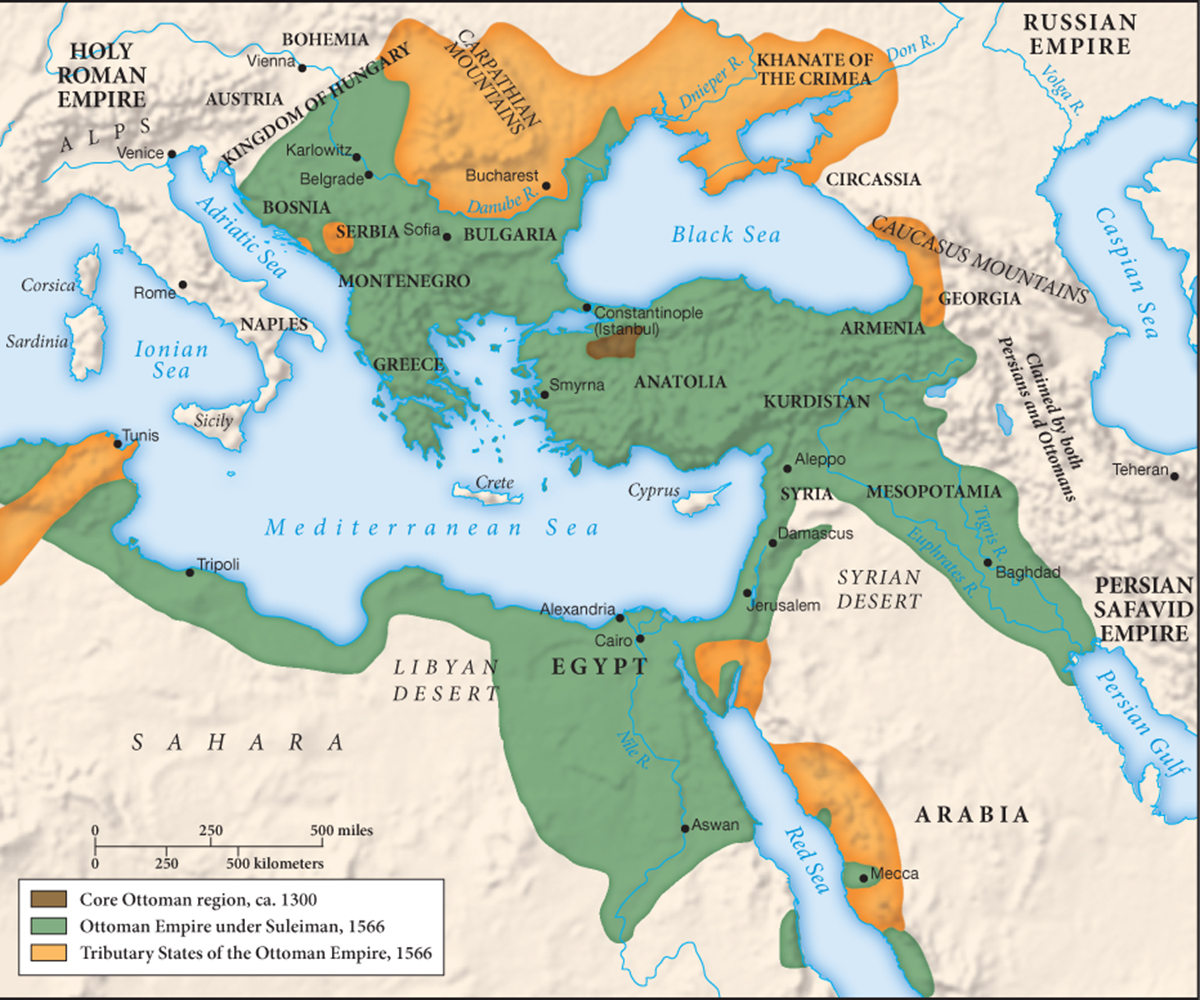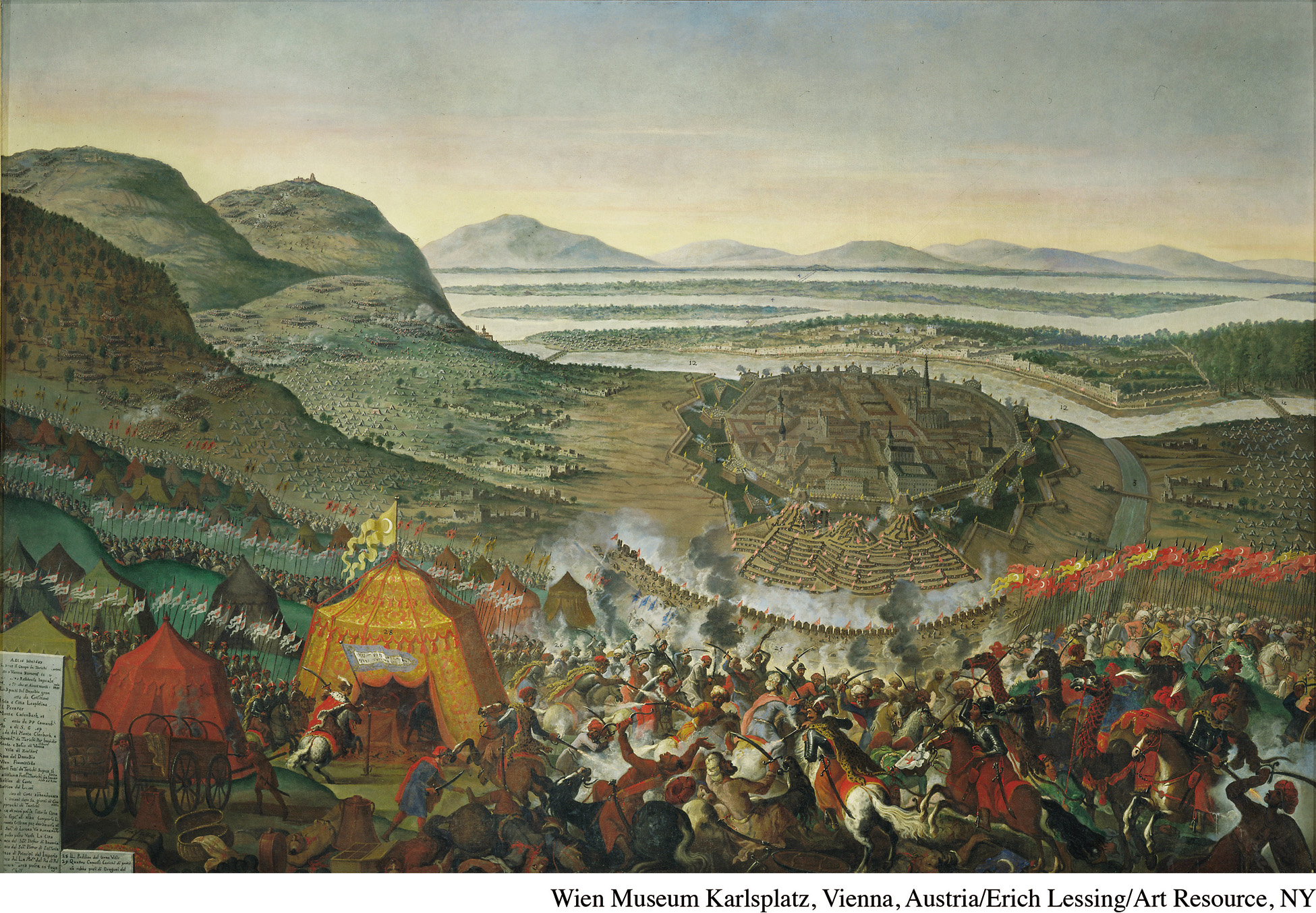Muslims and Christians in the Ottoman Empire
Like the Mughal state, the Ottoman Empire was also the creation of Turkic warrior groups, whose aggressive raiding of agricultural civilization was now legitimized in Islamic terms. Beginning around 1300 from a base area in northwestern Anatolia, these Ottoman Turks over the next three centuries swept over much of the Middle East, North Africa, and southeastern Europe to create the Islamic world’s most significant empire (see Map 13.4). During those centuries, the Ottoman state was transformed from a small frontier principality to a prosperous, powerful, cosmopolitan empire, heir both to the Byzantine Empire and to leadership within the Islamic world. Its sultan combined the roles of a Turkic warrior prince, a Muslim caliph, and a conquering emperor, bearing the “strong sword of Islam” and serving as chief defender of the faith.

Gaining such an empire transformed Turkish social life as well. The relative independence of Central Asian pastoral women, their open association with men, and their political influence in society all diminished as the Turks adopted Islam, beginning in the tenth century, and later acquired an empire in the heartland of ancient and patriarchal Mediterranean civilizations. Now elite Turkish women found themselves secluded and often veiled; slave women from the Caucasus Mountains and the Sudan grew more numerous; official imperial censuses did not count women; and orthodox Muslim reformers sought to restrict women’s religious gatherings.
And yet within the new constraints of a settled Islamic empire, Turkish women retained something of the social power they had enjoyed in pastoral societies. From around 1550 to 1650, women of the royal court had such an influence in political matters that their critics referred to the “sultanate of women.” Islamic law permitted women important property rights, which enabled some to become quite wealthy, endowing religious and charitable institutions. Many women actively used the Ottoman courts to protect their legal rights in matters of marriage, divorce, and inheritance, sometimes representing themselves or acting as agents for female relatives. In 1717, the wife of an English ambassador to the Ottoman Empire compared the lives of Turkish and European women, declaring, “’Tis very easy to see that they have more liberty than we have.”31
Significance
In what ways was the Ottoman Empire important for Europe in the early modern era?
Within the Islamic world, the Ottoman Empire represented the growing prominence of Turkic people, for their empire now incorporated a large number of Arabs, among whom the religion had been born. The responsibility and the prestige of protecting Mecca, Medina, and Jerusalem—
The Ottoman Empire, like its Mughal counterpart, was the site of a highly significant cross-
In the empire’s southeastern European domains, known as the Balkans, the Ottoman encounter with Christian peoples unfolded quite differently than it had in Anatolia. In the Balkans, Muslims ruled over a large Christian population, but the scarcity of Turkish settlers and the willingness of the Ottoman authorities to accommodate the region’s Christian churches led to far fewer conversions. By the early sixteenth century, only about 19 percent of the area’s people were Muslims, and 81 percent were Christians.
Many of these Christians had welcomed Ottoman conquest because taxes were lighter and oppression less pronounced than under their former Christian rulers. Christian communities such as the Eastern Orthodox and Armenian Churches were granted considerable autonomy in regulating their internal social, religious, educational, and charitable affairs. Nonetheless, many Christian and Jewish women appealed legal cases dealing with marriage and inheritance to Muslim courts, where their property rights were greater. A substantial number of Christian men—
Even though Ottoman authorities were relatively tolerant toward Christians within their borders, the empire itself represented an enormous threat to Christendom generally. The seizure of Constantinople, the conquest of the Balkans, Ottoman naval power in the Mediterranean, and the siege of Vienna in 1529 and again in 1683 raised anew “the specter of a Muslim takeover of all of Europe.”32 (See Working with Evidence, Source 13.2.) One European ambassador reported fearfully in 1555 from the court of the Turkish ruler Suleiman:
He tramples the soil of Hungary with 200,000 horses, he is at the very gates of Austria, threatens the rest of Germany, and brings in his train all the nations that extend from our borders to those of Persia.33
Indeed, the “terror of the Turk” inspired fear across much of Europe and placed Christendom on the defensive, even as Europeans were expanding aggressively across the Atlantic and into the Indian Ocean.

But the Ottoman encounter with Christian Europe spawned admiration and cooperation as well as fear and trembling. Italian Renaissance artists portrayed the splendor of the Islamic world. (See Working with Evidence, Chapter 12.) The sixteenth-